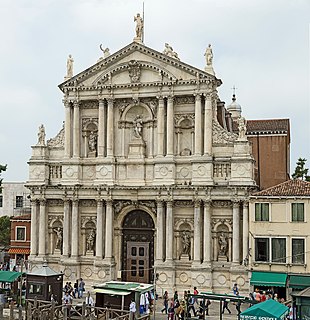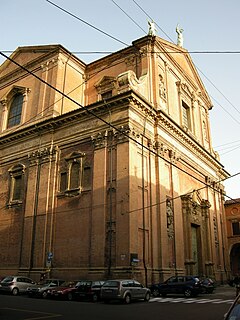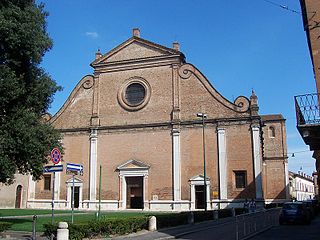Related Research Articles

Pietro Lorenzetti or Pietro Laurati was an Italian painter, active between c.1306 and 1345. Together with his younger brother Ambrogio, he introduced naturalism into Sienese art. In their artistry and experiments with three-dimensional and spatial arrangements, the brothers foreshadowed the art of the Renaissance.

Santa Maria dei Miracoli and Santa Maria di Montesanto are two churches in Rome.

Sant'Anna dei Lombardi,, and also known as Santa Maria di Monte Oliveto, is an ancient church and convent located in piazza Monteoliveto in central Naples, Italy. Across Monteoliveto street from the Fountain in the square is the Renaissance palace of Orsini di Gravina.

San Nicola da Tolentino agli Orti Sallustiani is a church in Rome. It is referred to in both Melchiori's and Venuti's guides as San Niccolò di Tolentino, and in the latter it adds the suffix a Capo le Case. It is one of the two Roman national churches of Armenia. The church was built for the Discalced Augustinians in 1599, and originally dedicated to the 13th century Augustinian monk, St. Nicholas of Tolentino.

The Basilica of Saint Nicolas of Tolentino is a Roman Catholic church and minor basilica that is part of the Augustinian monastery in the hill-town of Tolentino, province of Macerata, Marche, central Italy. The church is a former cathedral of the Roman Catholic Diocese of Tolentino, suppressed in 1586.

San Bernardino is a church in Verona, northern Italy. The church, in Gothic style, was built from 1451 to 1466.

The Church of San Marco in San Girolamo is a baroque parish church in Vicenza, northern Italy, built in the 18th century by the Discalced Carmelites. It houses various artworks by artists of the early 18th century from Veneto. The sacristy preserves its original furniture of the same period.

Santa Maria di Nazareth is a Roman Catholic Carmelite church in Venice, northern Italy. It is also called Church of the Scalzi being the seat in the city of the Discalced Carmelites religious order. Located in the sestiere of Cannaregio, near Venezia Santa Lucia railway station, it was built in the mid 17th century to the designs of Baldassarre Longhena and completed in the last decades of that century.

San Giovanni Evangelista is a church in Parma, northern Italy, part of a complex also including a Benedictine convent and grocery.

The Church of St. John in Aix-en-Provence, situated at the corner of rue d'Italie and rue Cardinale, is a Gothic Roman Catholic church, the first in Provence. It was built in the 13th century, mostly in the 1270s.

Santissimo Salvatore is a Baroque-style Roman Catholic church in central Bologna, Italy.
The Sanctuary of Santa Maria di Galloro is a church located on the via Appia Nuova, near Ariccia on the road to Genzano di Roma, in the region of Lazio, in Italy.
San Biagio is a Baroque architecture, Roman Catholic church, located on Via del Carmine #4 in central Modena, Italy.

San Vitale is a Baroque style, Roman Catholic church located in central Parma, region of Emilia Romagna, Italy.

The Church of the Theatines (Teatini), also known as Santa Maria della Pietà is a Roman Catholic, Baroque-style church and monastery located on Corso della Giovecca, in central Ferrara, region of Emilia-Romagna, Italy.
San Giorgio is a late-Renaissance-style, Roman Catholic parish church located in Casalbuttano, Province of Cremona, region of Lombardy, Italy.

San Francesco is a late-Renaissance, Roman Catholic minor basilica church located on via Terranuova in Ferrara, region of Emilia-Romagna, Italy.
San Marcellino, also known as San Marcellino e Pietro, is a Baroque-style, Roman Catholic church located on Via Ponchielli in Cremona, region of Lombardy, Italy.
San Giovanni Battista is a Baroque-style Roman Catholic church located on Via XX settembre #1870 in Rimini, region of Emilia-Romagna, Italy.

The Pisa Altarpiece was a large multi-paneled altarpiece produced by Masaccio for the chapel of Saint Julian in the church of Santa Maria del Carmine in Pisa. The chapel was owned by the notary Giuliano di Colino, who commissioned the work on February 19, 1426 for the sum of 80 florins. Payment for the work was recorded on December 26 of that year. The altarpiece was dismantled and dispersed to various collections and museums in the 18th century, but an attempted reconstruction was made possible due to a detailed description of the work by Vasari in 1568.
References
- ↑ Nuova guida di Cremona, by Giuseppe Picenardi, Cremona, 1820, pages 224-226.
- ↑ Comune of Cremona Tourism office, entry on church.